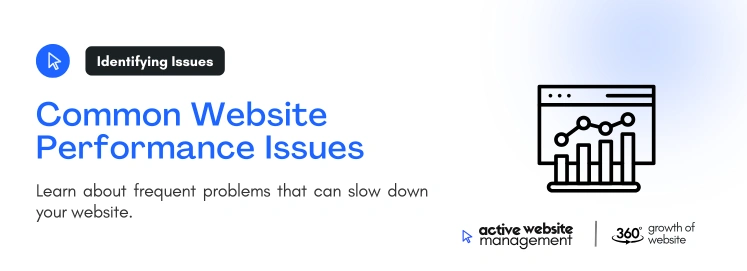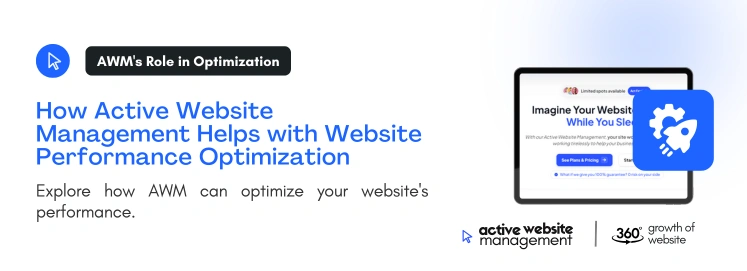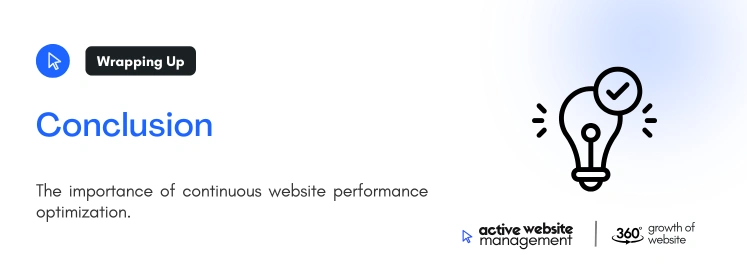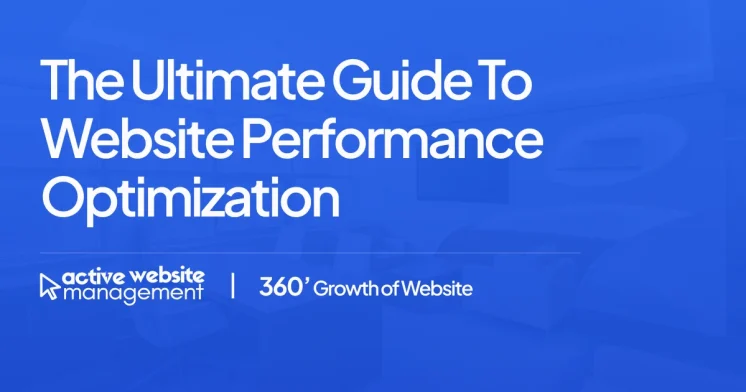
Website performance optimization is one of the most critical elements in maintaining a successful online presence. A well-optimized website not only improves user experience but also ranks higher on search engines, loads faster, and has better engagement metrics. Whether you’re running a small business or managing a high-traffic website, optimizing your site for performance is a must in today’s fast-paced digital world.
In this guide, we’ll explore everything you need to know about website performance optimization, how it impacts your online presence, and provide actionable tips on how to improve it. Additionally, we will discuss how Active Website Management (AWM) plays a crucial role in ensuring continuous performance optimization for your website.
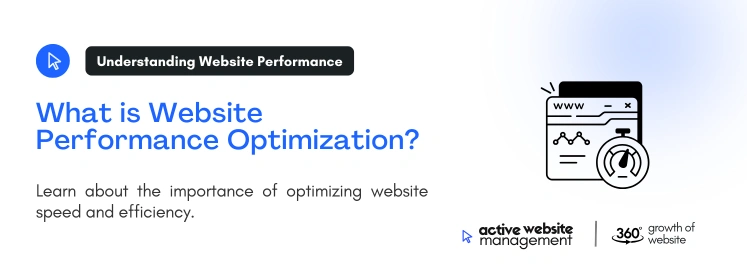
Website performance optimization refers to the process of improving how efficiently a website functions, ensuring faster load times, smoother user interactions, and better overall site functionality. Optimization encompasses various strategies, including reducing file sizes, optimizing server performance, leveraging caching, and ensuring all media is displayed correctly without sacrificing speed or user experience.
Website performance isn’t a one-time task; it requires ongoing attention. As you continue to grow your website, the amount of content, data, and scripts increases, so regularly optimizing these elements keeps your site functioning efficiently.
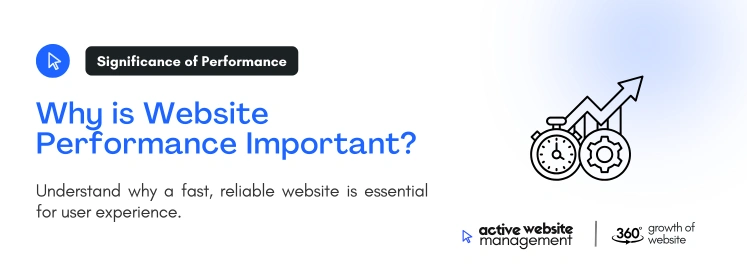
In today’s competitive digital landscape, website performance is a key determinant of your online success. Here are the main reasons why website performance optimization should be at the forefront of your digital strategy:
Users expect websites to load quickly. Studies show that if a website takes more than 3 seconds to load, 40% of visitors abandon it. A slow website can lead to poor user experience, high bounce rates, and lost potential customers. In contrast, a fast website keeps users engaged, leading to better retention rates and higher engagement.
Don't Wait for Growth—Accelerate It with Active Website Management
Search engines like Google consider website speed as a ranking factor. Optimizing your website ensures that it ranks higher in search results, improving its visibility to potential visitors. Faster websites are also crawled more efficiently by search engine bots, further enhancing their SEO performance.
For businesses, especially those that depend on eCommerce or lead generation, website performance directly impacts revenue. Faster websites lead to higher conversion rates. Amazon, for example, found that every 100-millisecond increase in page load time resulted in a 1% decrease in sales.
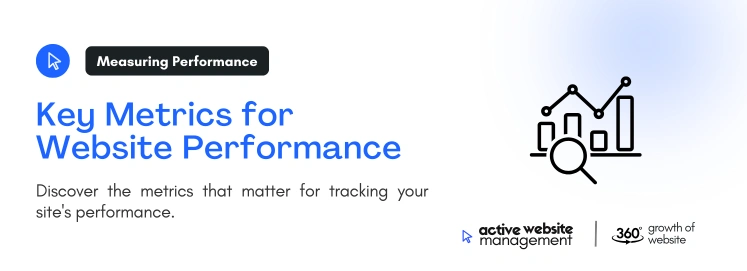
To ensure your website is optimized, it’s essential to measure key performance metrics regularly. Here are the most important ones:
This metric measures how long it takes for your website to fully load for users. The goal should be to keep this under 3 seconds.
TTFB measures the time it takes for a user’s browser to receive the first byte of information from the server. A lower TTFB indicates a more responsive website.
Core Web Vitals are a set of user-centric metrics defined by Google to measure aspects of website performance such as loading speed, interactivity, and visual stability. These metrics include:
Here are some of the most frequent issues that can slow down a website:
Large images that aren’t compressed can severely impact load times. Many website owners overlook image optimization, resulting in heavy files that slow down performance.
A slow server response time can significantly delay the delivery of content to users. It’s essential to choose a reliable hosting provider that offers optimized server performance.
Don't Wait for Growth—Accelerate It with Active Website Management
Excessive or poorly written code can increase the time it takes for a browser to process a page. This includes unnecessary JavaScript, CSS, or HTML that doesn’t contribute to the core functionality of the site.
Failing to implement browser or server-side caching means that users must load every element of your site every time they visit. Caching stores commonly accessed files, making subsequent visits much faster.
Here are some practical steps you can take to ensure your website performs at its best:
Use modern formats like WebP, which offer excellent compression with little quality loss. Ensure that your images are compressed and scaled appropriately for various devices.
Minify CSS, JavaScript, and HTML files to remove unnecessary characters such as spaces and comments. Compression using tools like Gzip can reduce file sizes even further.
CDNs distribute your website content across multiple servers around the globe, reducing the time it takes for users to download files. This results in faster load times regardless of a user’s location.
Choose a fast, reliable hosting provider and consider upgrading to a dedicated or virtual private server (VPS) if your current host isn’t providing sufficient speed.
Browser caching allows visitors’ browsers to store copies of website files, reducing load time on repeat visits. Leverage browser caching for static resources like images, CSS, and JavaScript files.
Active Website Management (AWM) ensures that your website is continuously optimized for performance without you having to worry about it. Here’s how AWM can make a difference:
With AWM, your website undergoes regular performance audits to detect and resolve issues early. These audits check for potential bottlenecks, such as slow-loading pages or server response issues, ensuring that everything runs smoothly.
AWM automatically optimizes images by compressing them without compromising quality. This ensures your website loads faster and doesn’t waste server resources.
As search engines refine their algorithms, AWM keeps your website aligned with the latest technical SEO best practices. This includes optimizing for Core Web Vitals and ensuring fast page load times.
Website security can have a direct impact on performance. AWM ensures that your website receives timely updates for all security patches and performance-related plugins or tools, reducing downtime and potential slowdowns.
Technical SEO focuses on the backend aspects of your website, including how it’s structured and how fast it loads, which can significantly affect your performance on search engines. Technical SEO helps by:
To accurately measure your website’s performance, you can use the following tools:
PageSpeed Insights is a free tool from Google that evaluates the performance of your website and provides specific recommendations for improvement.
GTmetrix offers detailed performance reports, breaking down speed, loading times, and other metrics.
Lighthouse is a powerful tool integrated into Chrome DevTools, helping you run audits for performance, accessibility, SEO, and more.
As technology evolves, website performance optimization is also advancing. Here are some trends to keep an eye on:
Artificial intelligence is playing an increasing role in website optimization, enabling automated processes for image compression, content delivery, and predictive caching based on user behavior.
With serverless computing, websites can dynamically scale resources based on demand, reducing costs and improving load times.
Website performance optimization is crucial for businesses of all sizes. By focusing on improving speed, enhancing user experience, and implementing SEO best practices, you can ensure your website drives results and remains competitive. Whether you’re managing a small blog or a high-traffic eCommerce site, these strategies will help you optimize for better performance.
With Active Website Management, you have a continuous partner that ensures your website is optimized every month. From image optimization to regular audits and performance updates, AWM takes the guesswork out of website management and ensures that your site is always running at its best.
By following the steps outlined in this guide, you’ll not only improve your website’s performance but also create a more engaging experience for your users, leading to better SEO, higher conversions, and ultimately, more success in the digital space.

Be quick! Spots are almost gone for September. - Starts at ₹6666/month
Get started with AWM today and watch your website grow.
Our expert team is ready to help.
We respect your privacy. Unsubscribe anytime.
We respect your privacy. Unsubscribe anytime.
